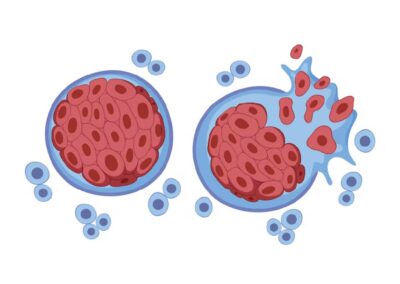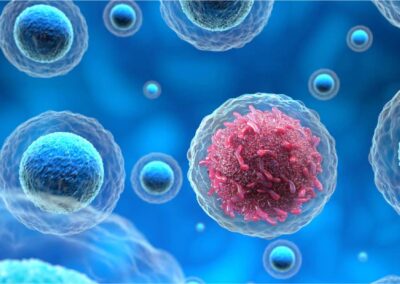Tumor markers are substances produced by cancerous or other abnormal tissues in the body. These markers can be detected and measured in blood, urine, or tissue samples. Some tumor markers are released directly by the tumor, while others are produced by the body in response to the presence of cancer. When a tumor develops or changes, levels of specific tumor markers may rise, which can assist in diagnosing cancer, monitoring disease progression, treatment response, and metastasis.
However, tumor markers should not be used as the sole method of diagnosis. They must be interpreted in combination with other diagnostic procedures such as imaging studies, tissue biopsies, and clinical evaluations. Therefore, consultation with a medical professional is essential for accurate diagnosis and treatment planning.

Benefits of Using Tumor Markers in Cancer Prevention and Treatment
- Early Detection
Tumor markers may help identify cancer at an early stage, allowing for prompt treatment and improved prognosis. - Monitoring Treatment Response
Changes in tumor marker levels can reflect how well a treatment is working, enabling adjustments to therapy as needed. - Prognosis and Risk Assessment
Tumor markers may provide insights into the potential for recurrence or progression, and help predict treatment outcomes.
Limitations of Tumor Markers in Cancer Management
- Lack of Specificity
Some tumor markers can be elevated in non-cancerous conditions, leading to false positives and unnecessary anxiety. Further confirmation through other diagnostic tools is required. - Variability Among Individuals
Marker levels can vary from person to person, making it difficult to establish universal cutoff values for diagnosis or monitoring. - Limited Sensitivity
Some types of cancer may not produce detectable levels of tumor markers, which could result in missed diagnoses or insufficient monitoring.

Applications of Tumor Markers in Cancer Care
- Screening
Tumor markers can be used as part of a cancer screening program for cancers such as breast, ovarian, or prostate cancer. - Diagnosis
When used alongside other diagnostic tools like imaging or biopsies, tumor markers can support cancer diagnosis. - Monitoring
Tumor markers are valuable for tracking the effectiveness of treatment and detecting recurrence or disease progression. - Prognosis
Tumor marker levels can help estimate disease outcomes and inform treatment planning.

Guidelines for Tumor Marker Testing
- Consult a Healthcare Professional
Interpretation of tumor marker results should be done by a qualified medical provider to support diagnosis and treatment decisions. - Regular Monitoring
Tumor marker levels should be tracked at medically appropriate intervals, as recommended by a specialist. - Use in Combination with Other Tests
Tumor marker testing should be integrated with other diagnostic modalities such as imaging and biopsy for accurate diagnosis and monitoring.

Commonly Known Tumor Markers by Cancer Type
- PSA (Prostate-Specific Antigen)
Used to detect and monitor prostate cancer. - CEA (Carcinoembryonic Antigen)
Associated with colon, pancreatic, and lung cancers. - CA-125
Used for ovarian cancer detection and monitoring. - CA 19-9
Linked to pancreatic, colorectal, and other gastrointestinal cancers. - AFP (Alpha-Fetoprotein)
Used for liver cancer detection and germ cell tumors (testicular or ovarian). - HCG (Human Chorionic Gonadotropin)
Associated with germ cell tumors, including testicular and ovarian cancers. - CA 15-3 / CA 27.29
Used to monitor treatment response in breast cancer. - HER2/neu
Overexpression is linked to aggressive breast and ovarian cancers. - TG (Thyroglobulin)
Used to monitor treatment response in thyroid cancer. - Neuroendocrine Markers (e.g., Chromogranin A, Synaptophysin)
Associated with neuroendocrine tumors.
https://www.si.mahidol.ac.th/th/healthdetail.asp?aid=618
https://mt.ams.cmu.ac.th/upload/content_attached/%E0%B8%81%E0%B8%B2%E0%B8%A3%E0%B9%83%E0%B8%AB%E0%B9%89%E0%B8%84%E0%B8%B3%E0%B8%9B%E0%B8%A3%E0%B8%B6%E0%B8%81%E0%B8%A9%E0%B8%B2-Tumor-marker.pdf
http://www.cai.md.chula.ac.th/lesson/lesson4809/html/2_1char.html
https://www.cancer.gov/about-cancer/diagnosis-staging/diagnosis/Tumor-markers-fact-sheet
si.mahidol.ac.th
คณะแพทยศาสตร์ศิริราชพยาบาล มหาวิทยาลัยมหิดล
Faculty of Medicine Siriraj Hospital, คณะแพทยศาสตร์ศิริราชพยาบาล , Siriraj Hospital, โรงพยาบาลศิริราช
National Cancer InstituteNational Cancer Institute
Tumor Markers
A fact sheet that defines Tumor markers and describes how they can be used to aid diagnosis and treatment.


